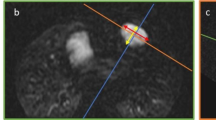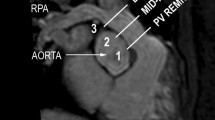Abstract
Background
Pulmonary valve replacement is recommended in patients with repaired tetralogy of Fallot based on cardiac magnetic resonance imaging (MRI) criteria. This procedure is performed by surgical or transcatheter approaches.
Objective
We aimed to investigate the differences in preprocedural MRI characteristics (volume, function, strain) and morphology of the right ventricular outflow tract and branch pulmonary arteries in patients for whom surgical or transcatheter pulmonary valve replacement was planned.
Materials and methods
Cardiac MRI of 166 patients with tetralogy of Fallot were analyzed. Of these, 36 patients for whom pulmonary valve replacement was planned were included. Magnetic resonance imaging characteristics, right ventricular outflow tract morphology, branch pulmonary artery flow distribution and diameter were compared between surgical and transcatheter groups. Spearman correlation and Kruskal–Wallis tests were performed.
Results
Circumferential and radial MRI strain for the right ventricle were lower in the surgical group (P=0.045 and P=0.046, respectively). The diameter of the left pulmonary artery was significantly lower (P=0.021) and branch pulmonary artery flow and diameter ratio were higher (P=0.044 and P = 0.002, respectively) in the transcatheter group. There was a significant correlation between right ventricular outflow tract morphology and right ventricular end-diastolic volume index and global circumferential and radial MRI strain (P=0.046, P=0.046 and P= 0.049, respectively).
Conclusion
Preprocedural MRI strain, right-to-left pulmonary artery flow, diameter ratio and morphological features of the right ventricular outflow tract were significantly different between the two groups. A transcatheter approach may be recommended for patients with branch pulmonary artery stenosis, since both pulmonary valve replacement and branch pulmonary artery stenting can be performed in the same session.





Similar content being viewed by others
Data Availability
The data used to support the findings of this study are included in the article. The study cohort is available upon request for some participating centers but not all due to relevant data protection laws.
References
Flors L, Bueno J, Gish D et al (2020) Preprocedural imaging evaluation of pulmonary valve replacement after repair of tetralogy of Fallot: what the radiologist needs to know. J Thorac Imaging 35:153–166
Geva T (2011) Repaired tetralogy of Fallot: the roles of cardiovascular magnetic resonance in evaluating pathophysiology and for pulmonary valve replacement decision support. J Cardiovasc MagnReson 13:9
Therrien J, Provost Y, Merchant N et al (2005) Optimal timing for pulmonary valve replacement in adults after tetralogy of Fallot repair. Am J Cardiol 95:779–782
Stout KK, Daniels CJ, Aboulhosn JA et al (2019) 2018 AHA/ACC guideline for the management of adults with congenital heart disease: executive summary: a report of the American College of Cardiology/American Heart Association task force on clinical practice guidelines. J Am Coll Cardiol 73:1494–1563
Baumgartner H, De Backer J, Babu-Narayan SV et al (2021) 2020 ESC Guidelines for the management of adult congenital heart disease. Eur Heart J 42:563–645
Gillespie MJ, Rome JJ, Levi DS et al (2012) Melody valve implant within failed bioprosthetic valves in the pulmonary position: a multicenter experience. Circ Cardiovasc Interv 5:862–870
Boshoff DE, Cools BL, Heying R et al (2013) Off-label use of percutaneous pulmonary valved stents in the right ventricular outflow tract: time to rewrite the label? Catheter. Cardiovasc Interv 81:987–995
Shen WC, Chen CA, Chang CI et al (2020) Outflow tract geometries are associated with adverse outcome indicators in repaired tetralogy of Fallot. J Thorac Cardiovasc Surg 162:196–205
Van De Bruaene A, Horlick EM, Benson L et al (2019) Characterization of the surgically modified RVOT using magnetic resonance angiography in adults late after tetralogy of Fallot repair. JACC Cardiovasc Imaging 12:1589–1591
Schievano S, Coats L, Migliavacca F et al (2007) Variations in right ventricular outflow tract morphology following repair of congenital heart disease: implications for percutaneous pulmonary valve implantation. J Cardiovasc Magn Reson 9:687–695
Davlouros PA, Kilner PJ, Hornung TS et al (2002) Right ventricular function in adults with repaired tetralogy of Fallot assessed with cardiovascular magnetic resonance imaging: detrimental role of right ventricular outflow aneurysms or akinesia and adverse right-to-left ventricular interaction. J Am Coll Cardiol 40:2044–2052
Geva T (2013) Indications for pulmonary valve replacement in repaired tetralogy of Fallot: the quest continues. Circulation 128:1855–1857
Oshinski JN, Parks WJ, Markou CP et al (1996) Improved measurement of pressure gradients in aortic coarctation by magnetic resonance imaging. J Am Coll Cardiol 28:1818–1826
Pettersen MD, Du W, Skeens ME et al (2008) Regression equations for calculation of z scores of cardiac structures in a large cohort of healthy infants, children, and adolescents: an echocardiographic study. J Am Soc Echocardiogr 21:922–934
Feltes TF, Bacha E, Beekman RH 3rd et al (2011) American Heart Association Congenital Cardiac Defects Committee of the Council on Cardiovascular Disease in the Young; Council on Clinical Cardiology; Council on Cardiovascular Radiology and Intervention; American Heart Association. Indications for cardiac catheterization and intervention in pediatric cardiac disease: a scientific statement from the American Heart Association. Circulation 123:2607–2652
Chung R, Taylor AM (2014) Imaging for preintervention planning: transcatheter pulmonary valve therapy. Circ Cardiovasc Imaging 7:182–189
Ferrari I, Shehu N, Mkrtchyan N et al (2020) Different 407 CMR imaging modalities for 408 native and patch-repaired right ventricular outflow tract sizing: impact on percutaneous pulmonary valve replacement planning. Pediatr Cardiol 41:382–388
Dandel M, Lehmkuhl H, Knosalla C et al (2009) Strain and strain rate imaging by echocardiography – basic concepts and clinical. Curr Cardiol Rev 5:133–148
Maceira AM, Tuset-Sanchis L, López-Garrido M et al (2018) Feasibility and reproducibility of feature-tracking-based strain and strain rate measures of the left ventricle in different diseases and gender. J MagnReson Imaging 47:1415–1425
Toro-Salazar OH, Gillan E, O’Loughlin MT et al (2013) Occult cardiotoxicity in childhood cancer survivors exposed to anthracycline therapy. Circulation 6:873–880
Negishi K, Negishi T, Hare JL et al (2013) Independent and incremental value of deformation indices for prediction of trastuzumab-induced cardiotoxicity. J Am Soc Echocardiogr 26:493–498
Thavendiranathan P, Poulin F, Lim K-D et al (2014) Use of myocardial strain imaging by echocardiography for the early detection of cardiotoxicity in patients during and after cancer chemotherapy: a systematic review. J Am Coll Cardiol 63:2751–2768
Orwat S, Diller GP, Kempny A et al (2016) Myocardial deformation parameters predict outcome in patients with repaired tetralogy of Fallot. Heart 102:209–215
Anwar S, Harris MA, Whitehead KK et al (2017) The impact of the right ventricular outflow tract patch on right ventricular strain in tetralogy of Fallot: a comparison with valvar pulmonary stenosis utilizing cardiac magnetic resonance. Pediatr Cardiol 38:617–623
Moceri P, Duchateau N, Gillon S et al (2021) Three-dimensional right ventricular shape and strain in congenital heart disease patients with right ventricular chronic volume loading. Eur Heart J Cardiovasc Imaging 22:1174–1181
Zablah JE, Misra N, Gruber D et al (2017) Comparison of patients undergoing surgical versus transcatheter pulmonary valve replacement: criteria for referral and mid-term outcome. Pediatr Cardiol 38:603–607
Wald RM, Haber I, Wald R et al (2009) Effects of regional dysfunction and late gadolinium enhancement on global right ventricular function and exercise capacity in patients with repaired tetralogy of Fallot. Circulation 119:1370–1377
Babu-Narayan SV, Kilner PJ, Li W et al (2006) Ventricular fibrosis suggested by cardiovascular magnetic resonance in adults with repaired tetralogy of Fallot and its relationship to adverse markers of clinical outcome. Circulation 113:405–413
Gatzoulis MA, Balaji S, Webber SA et al (2000) Risk factors for arrhythmia and sudden cardiac death late after repair of tetralogy of Fallot: a multicentre study. The Lancet 356:975–981
Valente AM, Gauvreau K, Assenza GE et al (2014) Contemporary predictors of death and sustained ventricular tachycardia in patients with repaired tetralogy of Fallot enrolled in the INDICATOR cohort. Heart 100:247–253
McElhinney DB, Parry AJ, Reddy VM et al (1998) Left pulmonary artery kinking caused by outflow tract dilatation after transannular patch repair of tetralogy of Fallot. Ann Thorac Surg 65:1120–1126
Harris MA, Whitehead KK, Gillespie MJ et al (2011) Differential branch pulmonary artery regurgitant fraction is a function of differential pulmonary arterial anatomy and pulmonary vascular resistance. JACC Cardiovasc Imaging 4:506–513
Hickey EJ, Veldtman G, Bradley TJ et al (2009) Late risk of outcomes for adults with repaired tetralogy of Fallot from an inception cohort spanning four decades. Eur J Cardiothorac Surg 35:156–164
Hennein HA, Mosca RS, Urcelay G et al (1995) Intermediate results after complete repair of tetralogy of Fallot in neonates. J Thorac Cardiovasc Surg 109:332–344
Sutton NJ, Peng L, Lock JE et al (2008) Effect of pulmonary artery angioplasty on exercise function after repair of tetralogy of Fallot. Am Heart J 155:182–186
Ou-Yang WB, Qureshi S, Ge JB et al (2020) Multicenter comparison of percutaneous and surgical pulmonary valve replacement in large RVOT. Ann Thorac Surg 110:980–987
Author information
Authors and Affiliations
Contributions
All authors contributed to the study conception and design. Material preparation, data collection and analysis were performed by S.O., B.K and O.K. The first draft of the manuscript was written by S.O.; all authors commented on the drafts of the manuscript. All authors read and approved the final manuscript.
Corresponding author
Ethics declarations
Ethics approval
This study was performed in line with the principles of the Declaration of Helsinki. Approval was granted by the Ethics Committee of Istanbul Medeniyet University (Date, 25.12.2019 /No. 2019/052).
Conflicts of interest
None
Additional information
Publisher's note
Springer Nature remains neutral with regard to jurisdictional claims in published maps and institutional affiliations.
Rights and permissions
Springer Nature or its licensor (e.g. a society or other partner) holds exclusive rights to this article under a publishing agreement with the author(s) or other rightsholder(s); author self-archiving of the accepted manuscript version of this article is solely governed by the terms of such publishing agreement and applicable law.
About this article
Cite this article
Ozkok, S., Ciftci, H.O., Kose, K.B. et al. Surgical and transcatheter pulmonary valve replacement in patients with repaired tetralogy of Fallot: cardiac magnetic resonance imaging characteristics and morphology of right ventricular outflow tract. Pediatr Radiol 53, 1863–1873 (2023). https://doi.org/10.1007/s00247-023-05645-2
Received:
Revised:
Accepted:
Published:
Issue Date:
DOI: https://doi.org/10.1007/s00247-023-05645-2




